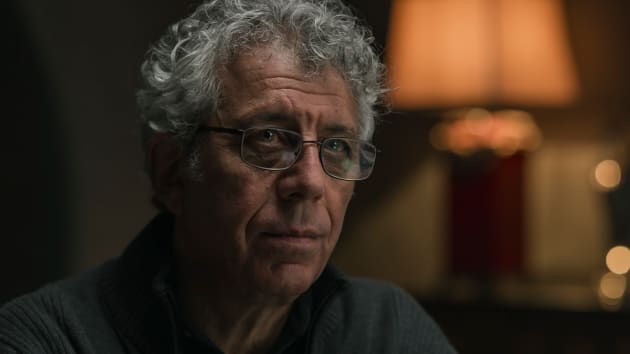Writer and director Naomi Jaye has taken the unpromising story of a soft-spoken young librarian and turned it into a small wonder of a film, eloquent and captivating. Britt Lower (Helly in Severance) is subtle but magnetic as Miriam, who works in a neighborhood library in Toronto, eating lunch alone every day in a nearby park. She seems content with her quiet life, even when wafting a little robotically through the library stacks in her oversized sweater. Whether her aura suggests sadness or complacency we don’t yet know.
The film has a definite narrative trajectory, as Miriam begins a relationship with Janko (Tom Mercier), a Slovenian taxi diver and artist who eats lunch on the park bench across from her. But its distinctive quality comes from how deftly Jaye balances that story with Miriam’s inner life. She delicately moves us in and out of Miriam’s memories and observances, with an occasional poetic touch, yet the film never loses its tether to the real world.
Darkest Miriam
The Bottom Line
An elegant, imaginative gem.
Venue: Tribeca Film Festival (Viewpoints)Cast: Britt Lower, Tom Mercier, Sook-Yin Lee, Jean YoonDirector and writer: Naomi Jaye
1 hour 27 minutes
Much of that reality depends on Lower’s layered performance. Even when Miriam is enigmatic, Lower suggests the depth and, as it turns out, grief beneath her self-protective calm. The tone itself is not grim though. In voiceover, Miriam wryly describes the library’s regular visitors, filing reports on any disruptive event. Deadpan, she describes Suitcase Man, who always carries one, Fainting Man, who often does, and Unusually Pale Female Patron.
The odd, almost fantastical events kick in gradually. Miriam discovers letters stashed in books and signed Rigoletto, as in the opera her father took her to when she was a child. “I am Rigoletto and I will not be doing any more suffering,” one reads. Others seem to be explicitly about Miriam, referencing her movements through the library.
This plot thread doesn’t play out as a detective story, even though Miriam’s boss and a police officer also read the letters, so we know they exist. Jaye treats it as a psychological mystery, part of the key to Miriam. Her father is the touchstone. We don’t learn until nearly halfway into the film that he has died, although we have seen him in Miriam’s memory. He sits in the garage surrounded by books piled to the ceiling, the image sending an unspoken signal that something is off. But she tells Janko he is alive and selling insurance.
Mercier’s performance also reflects the film’s understated tone perfectly. Janko is just as soft-spoken as Miriam, but more direct and open than she can be. He nicknames her Darkest Miriam, but his own paintings include a textured, entirely black canvas. As a couple they seem like a perfect fit.
The film is based on a 2009 novel by Martha Baillie called The Incident Report, composed entirely of reports Miriam has filed. Darkest Miriam is far less elliptical, yet it is also comfortable with leaving things unexplained, allowing viewers to piece together what they will. Questions and strange events begin to pile up. Riding her bike home one evening Miriam falls into a construction hole, and, unharmed, looks up at the night stars. While getting checked at the hospital the next day, she is asked questions she’d obviously rather not answer, including whether she’d ever had suicidal thoughts. The camera is close on Lower’s unmoving face and pained expression, as Miriam stares silently ahead.
Jaye is a Toronto-based installation artist as well as a filmmaker with one previous feature, The Pin (2013), but is scarcely known in the U.S. Darkest Miriam displays a sure sense of when to move the camera fluidly and when to let it sit, when to let images speak for themselves. Miriam seduces Janko by stopping on her way out of his apartment, turning to face him and matter-of-factly taking off her clothes as if she has simply made a decision. The film is full of risky choices that work. Miriam is often seen though windows or silhouetted against a doorway.
Between sequences, Jaye sometimes includes close-ups of flowers and plants in the park, once cutting from the darkness of Miriam’s father’s garage to the bright garden colors. In less capable hands this would all be pretentious, but Jaye maneuvers beautifully, using those touches just enough to evoke the mysteries of Miriam’s life.
There is a dramatic turn at the end that we don’t see coming, and Lower allows us to feel Miriam’s deep emotional pain, yet the film ends with Miriam pointed toward the future. That mix of the tragic and the hopeful is just the kind of off-kilter balance that makes the film so exceptional and compelling. Charlie Kaufman has lent his name to the project as an executive producer, and while there is a definite sympathy between his imaginative approach and hers, Jaye’s artistry comes through as purely hers, a true discovery.







